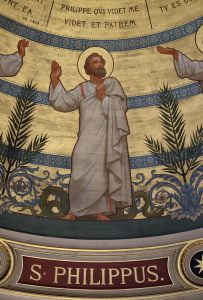
The Gospel of Philip was written between 150 CE and 350 CE. It is one of the Gnostic Gospels. It was lost for centuries until an Egyptian man rediscovered it by accident, buried in a cave near Nag Hammadi, in 1945.
Availability
Available for purchase (Leloup translation)
Entire text (Isenberg translation)
Excerpts (from Leloup translation of the Gospel of Philip)
60 This is how it is with those united in marriage.
The mystery which unites two beings is great;
without it, the world would not exist.
What gives substance to the world is Anthropos.
What gives substance to Anthropos
is an intimate and enduring relation [gamos]
Seek the experience of the pure embrace [koinonia];
it has great power;
contemplate the Presence in this impermanent body.
62 Do not fear the flesh nor be enamored of it.
If you fear it it will rule you.
If you love it, it will paralyze you and devour you.67 …Whoever is free of the world
can no longer be made into a slave there.
They have risen above attraction and repulsion.
They are master of their nature, free of envy.
If someone sees such a person, they seize them and hold them.
How can one be free of the powers
of attraction and repulsion? How can they then escape them?
Often there are those who come and say: “We are believers.”
They imagine themselves capable of escaping demons and unclean spirits.
If they had the Holy Breath in them,
no unclean spirits would adhere to them.71 When Eve was in Adam, there was no death; when she was separated from him, death came. If she enters back into him, and he accepts her, there will be no more death.
74 It is through the Breath that we come into being, but we are reborn by the Christ two by two. In his Breath, we experience a new embrace; we are no longer in duality, but in unity.
76 …the holy of holies is the bridal chamber [numphon], or communion.
Trust and consciousness in the embrace are exalted above all.
Those who truly pray to Jerusalem
are to be found only in the holy of holies … the bridal chamber.
What is the bridal chamber,
if not the place of trust and consciousness in the embrace?
It is an icon of Union,
beyond all forms of possession;
here is where the veil is torn from top to bottom;
here is where some arise and awaken.77 The powers can do nothing against those who are clothed in light;
they cannot see them.
All will be clothed in light
when they enter into the mystery of the sacred embrace.78 If woman had not been separated from man, she would not die with man.
Her separation was at the origin of death.
Christ comes again to heal this wound,
to rediscover the lost unity,
to enliven those who kill themselves in separation,
reviving them in union.84 There are two trees in the middle of the garden [paradeisos]:
One engenders animals, the other engenders humans.
Adam ate from the tree that engenders animals,
and became animal.
It is good to revere animals,
for they are like the first humans.
The tree from which Adam ate was the tree of animals, and it bore many fruits.
There is no lack of animal-humans,
they are many, and they revere each other.
In the beginning, God created humans;
then humans created gods.103-104 …A certain harmony is possible in this world,
where man and woman, strength and weakness, unite with each other.
In the Temple Space [Aeon], the form of union is different,
although we employ the same name for it;
but there exist forms of union higher than any that can be spoken,
stronger than the greatest forces,
with the power that is their destiny.
Those who live this are no longer separated.
They are one, beyond bodily distinction.105 Is it not necessary for those who know this fullness to recognize each other?
Yet some do not;
they are deprived of this joy.
Those who recognize each other
know the joy [apolenein] of living together in this fullness.122 None can know the day when man and woman unite but themselves.
Even the worldly embrace is a mystery;
far more so, the embrace that incarnates the hidden union.
It is not only a reality of the flesh,
for there is silence in this embrace.
It does not arise from impulse or desire [epithumia];
it is an act of will.126 Glory beyond glory, power beyond power;
fullness is offered to us in the secret of vigilance;
the holy of holies is made manifest;
and through the sacred embrace, we are invited into the interior.
As long as this is hidden, unhappiness prevails;
it always poisons the seeds [sperma], and evil is at work.
But when it is manifest, the clear light will envelop all, and everyone who finds themselves in it will be anointed [khrisma].
Slaves and prisoners will be freed.126 …Those who were separated will reunite and become fertilized.
All those who practice the sacred embrace [koiton] will kindle the light;
they will not beget as people do
in ordinary marriages, which take place in darkness.127 If someone experiences Trust and Consciousness in the heart of the embrace,
they become a child of light.
If someone does not receive these,
it is because they remain attached to what they know;
when they cease to be attached, they will be able to receive them.
…For them, this world has become another world ….
They are one.Leloup, Jean-Yves. The Gospel of Philip: Jesus, Mary Magdalene, and the Gnosis of Sacred Union. Simon and Schuster, 2004.
